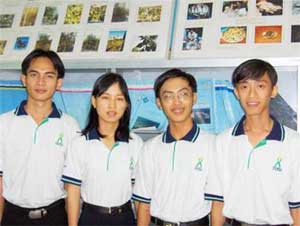Leveraging common plants in the Mekong Delta, such as water coconut, to treat livestock wastewater, and using banana sap to measure the levels of iron and aluminum in drinking water are innovative and fascinating discoveries.
These topics have also won second and third prizes at the Green Invention Contest organized by Sony…
Water Coconut for Wastewater Treatment
 |
|
The group “Green Reagents” (from left to right): Duc Thuan, My Loan, Tuan Vu, Truong Tho |
Testing water coconut for wastewater filtration was an idea that Vu Thuy Quang, a student majoring in agricultural environmental science at Can Tho University, came up with while studying the theoretical capabilities of aquatic plants.
Alongside Japanese water hyacinth, water coconut (also known as “Thuy Long”) thrives abundantly in the ponds and swamps of the Mekong Delta. During an internship in Binh An hamlet, Thanh Loi, Chau Phu (An Giang), witnessing the livestock wastewater from the area unable to drain into rivers, stagnating in ponds and creating foul odors, Quang and his classmate Nguyen Minh Thu immediately began conducting experiments.
After two months of diligently planting, observing, and analyzing water samples, Quang lost track of how many times he waded into the ponds to collect wastewater. “At first, it was quite daunting, but friends promised to give me some detergent to mask the smell, and I gradually got used to it,” Quang laughed.
The tireless days of experimentation ultimately yielded promising results. The water coconut exhibited vigorous growth when living in dense wastewater, with its stems, leaves, and color being significantly greener compared to those planted in clean water.
Analytical results showed a marked reduction in the concentration of pollutants. When trial-planted in aquaculture ponds, the roots of this plant provided a substrate for bacteria to thrive, filtering and absorbing solid waste, thus reducing the occurrence of algal blooms in the wastewater ponds.
Quang shared that after the water coconut, he is now nurturing a project on water filtration and composting for individual households.
Using Banana Sap to Measure Iron and Aluminum in Water
While washing green bananas one day, Tuan Vu noticed that the well water had turned a slightly reddish hue. Curious about the substance that reacted with the banana sap, Vu brought a sample of the water back to the lab for analysis. After much trial and error, Vu discovered that banana sap contained astringent properties, which would change color if the water contained high levels of iron.
Following this discovery, Vu and his friends: My Loan, Duc Thuan, and Truong Tho—students from the Faculty of Agriculture and Applied Biology at Can Tho University—eagerly began conducting experiments. Results from each trial using banana sap to test groundwater from wells showed a distinct color reaction between iron and banana sap. The higher the iron pollution in the water, the darker the red hue observed during testing. To confirm the effectiveness of this “reagent,” the group collected water samples from about 30 locations, not only in Can Tho but also in some districts in Hau Giang.
From the results of dozens of experiments, the group developed a color chart with five different levels, corresponding to the increasing intensity of color indicating the level of iron contamination in the water. Based on this, water can be categorized into different uses: water suitable for drinking and household use; water only suitable for livestock and agriculture; water that is contaminated but can still be used for washing animal enclosures; and water with high toxic substances.
Tuan Vu remarked that bananas are a common plant in the Mekong Delta, and almost every household grows them. The testing method is very simple. All it takes is to collect some water in a white plastic cap and cut a banana leaf to drip some sap into it; if the water turns a darker color, it indicates potential iron contamination. This method is cost-effective and provides immediate results. By identifying whether the water meets safety standards, users can decide how to utilize the water or how to filter and purify it before use.
Thu Thao

















































